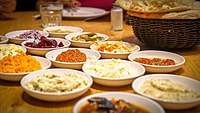Knish
A knish /kəˈnɪʃ/ is an traditional Ashkenazi Jewish[1] snack food consisting of a filling covered with dough that is typically baked, or sometimes deep fried.
 Knishes with mashed potato and fried onions | |
| Alternative names | Knysh |
|---|---|
| Type | Snack, side dish, finger food |
| Region or state | United States, Israel, other countries with a significant remaining Ashkenazi Jewish population |
| Created by | Jewish communities in Central and Eastern Europe |
| Main ingredients | Mashed potatoes, dough, ground meat, sauerkraut, onions, kasha, cheese |
Knishes can be purchased from street vendors in urban areas with a large Jewish population, sometimes at a hot dog stand or from a butcher shop. It is still strongly associated with the New York City region. It was made popular in North America by Ashkenazi Jewish refugees from the Pale of Settlement (mainly from present-day Belarus, Lithuania, Ukraine and eastern Poland).[2]
In most traditional versions, the filling is made entirely of mashed potato, kasha (buckwheat groats), or cheese. Other varieties of fillings include sweet potatoes, black beans, or spinach.
Knishes may be round, rectangular, or square. They may be entirely covered in dough or some of the filling may peek out of the top. Sizes range from those that can be eaten in a single bite hors d'oeuvre to sandwich-sized.
History in USA
Ashkenazi Jewish immigrants who arrived sometime around 1900 brought knishes to North America.[3] Knish (קניש) is a Yiddish word that was derived from the Ukrainian knysh (книш) and Polish knysz.[4][5] The first knish bakery in America was founded in New York City in 1910.[6] Generally recognized as a food made popular in New York City by Jewish immigrants in the early 1900s, the United States underwent a knish renaissance in the 2000s driven by knish specialty establishments such as the Knish Shop in Baltimore, Maryland,[7] Buffalo and Bergen[8] in Washington, DC, or My Mother's Knish,[9] in Westlake Village, California.
Similar dishes
Many culinary traditions feature similar baked, grilled, or fried dough-covered snacks (see list of dumplings), including the Cornish pasty, the Bedfordshire clanger, the Scottish Bridie, the Midwestern runza and bierock, the Jamaican patty, the Spanish and Latin American empanada, the Middle Eastern fatayer, the Portuguese rissol, the Italians panzerotto and calzone, the Central and South Asian samosa, the Czech klobasnek and kolache, the Romanian placinta, the Polish pierogi, the Russian and Ukrainian pirog, pirozhki and vatrushka, the Tatar peremech, the Russian-German bierock, the German Maultasche and the Southeast Asian curry puff.
See also
- Jewish cuisine – culinary traditions of Jewish communities around the world
- Turnover
- Yonah Shimmel's Knish Bakery – Bakery and restaurant located in Manhattan
References
- Wasserman, Tina. "Cooking: The Ultimate Jewish Finger Food". Reform Judaism Magazine. Archived from the original on December 22, 2010. Retrieved 2010-09-14.
- Silver, Laura (May 6, 2014). Knish: In Search of the Jewish Soul Food. Waltham, Mass.: Brandeis University Press. ISBN 978-1-61168-312-7.
- The Oxford Companion to American Food and Drink - Google Boeken. Books.google.com. Retrieved 2013-01-21.
- "Judaism 101: Jewish Cooking". Jewfaq.org. Retrieved 2013-01-21.
- "knish - definition of knish by the Free Online Dictionary, Thesaurus and Encyclopedia". Thefreedictionary.com. Retrieved 2013-01-21.
- (Kugel, Knishes, and Other Tasty Dishes by Nina Yellin, 2001)
- "The Knish Shop, Baltimore". Jewishinbaltimore.com. Retrieved 2013-01-21.
- "Gina Chersevani's Union Market Soda Shop and Bar Will Be Called Buffalo and Bergen | Food & Restaurant News". Washingtonian. 2012-05-24. Retrieved 2013-01-21.
- Alan RichmanPhotograph by Martin O'Neill. "A Mother's Knishes: Alan Richman". GQ. Retrieved 2013-01-21.

